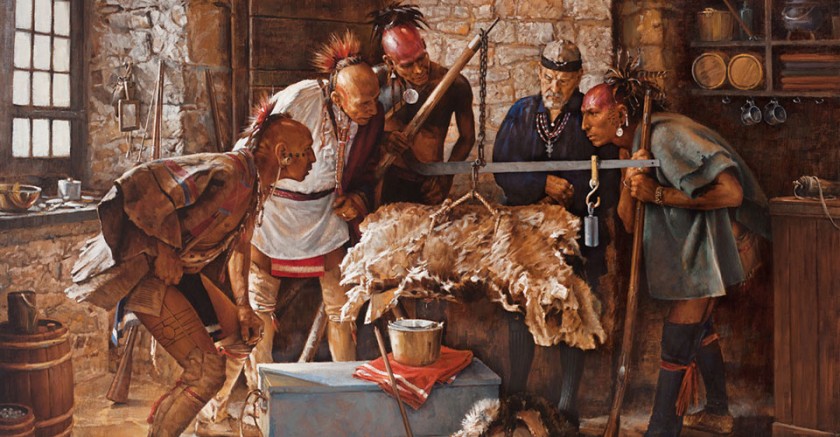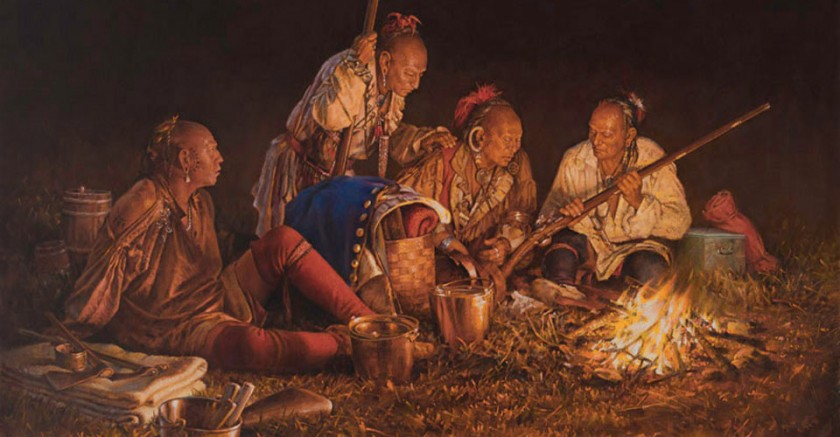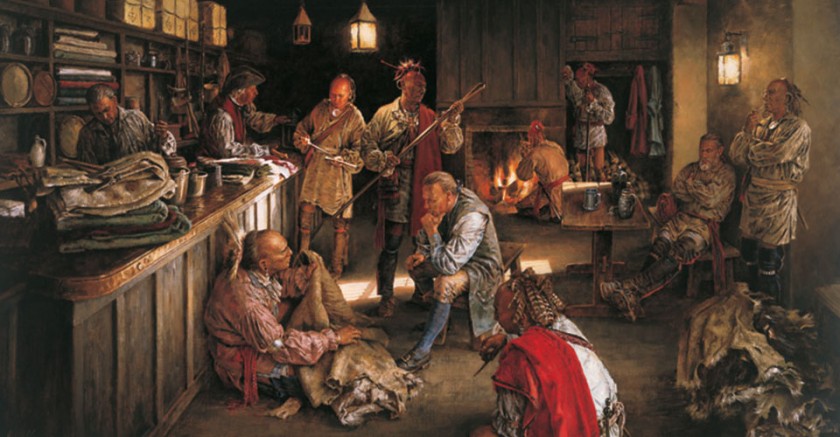 The key events described in Primitive Passions actually happened. In the mid-1680s, the fur trade at Albany had ground almost to a halt as the Iroquois could find fewer and fewer beaver in what is now upstate New York. In order to keep themselves supplied with arms with which to fight their enemies and the ironware which they had come to value, the Iroquois were forced to attack French trading parties. They raided those going to the Great Lakes for weapons and trade goods and those returning from the Great Lakes for furs which they would then trade at Albany.
The key events described in Primitive Passions actually happened. In the mid-1680s, the fur trade at Albany had ground almost to a halt as the Iroquois could find fewer and fewer beaver in what is now upstate New York. In order to keep themselves supplied with arms with which to fight their enemies and the ironware which they had come to value, the Iroquois were forced to attack French trading parties. They raided those going to the Great Lakes for weapons and trade goods and those returning from the Great Lakes for furs which they would then trade at Albany.
In addition, representatives of William Penn did try to buy the Susquehanna Valley and fur traders from Pennsylvania did make minor inroads among the Iroquois. In response, the Albany magistrates and traders, including Aernout C. Viele, used subterfuge to stymie Penn. The Iroquois did “suddenly” remember that they had given the Susquehanna Valley to the English.
The French, meanwhile, were doing all that they could to prevent the Dutch and English from usurping the fur trade of the western Indians while trying sway the allegiance of the Iroquois or, failing that, ensure their destruction. Governor La Barre did launch an attack on the Seneca, and his invasion did end ignobly with his force stricken with fever.
Throughout, the Iroquois believed that they could delay choosing sides until they could determine who was stronger – the French or English. For example, no one, least of all the Iroquois, really believed that the Duke of York’s Arms on their gates would stop the French. But, if they did, then it was proof that the English were stronger than the French. It was a diplomatic game the sachems would play with varying success until well into the 18th century.
The French Jesuits, while trying to “save” the savages, often played the role of agents provocateurs on behalf of the government of New France.
As the main events are real as described, so are most of the characters. Among the English such well-known personages as Robert Livingston, Col. Thomas Dongan, Major Patrick MacGregory and Lord Howard are real. All of the Dutch characters, with the exception of Laurentje van Reuyter, really lived. Real people among the French include Governor La Barre, the French Jesuit, Father De Lamberville, and the French officers, de Salvaye and Le Moyne de Longueuil.
All of the Iroquois sachems who spoke at the Albany councils — Odianne, Tekanista, Thanohjanihta and Adissas — actually did meet with Dongan and Lord Howard as described; and Garangula, the Onondaga sachem, did boldly rebuke Governor de La Barre in their meeting at La Famine. The quotes are accurate as recorded, although I have slightly updated the language.
In Savage Wilderness as well, the key events are as they occurred. In March 1685, King Louis XIV, “The Sun King,” appointed Jacques-René de Brisay de Denonville, Marquis de Denonville, governor of New France to replace the discredited Joseph Antoine de LaBarre. In his instructions to Denonville, the King said, “… he must lower the pride of the Iroquois, support the Illinois and the other allies whom Sieur de la Barre has abandoned, and by a firm and vigorous policy to let the said Iroquois know that they will have everything to fear if they do not submit to the conditions which he intends to impose on them.” From the outset, Denonville wanted to make King Louis proud.
He did plan a massive invasion of the Seneca lands to bring this proud and troublesome people to heel. In doing so, he cajoled Jean-Baptiste Colbert, Marquis de Seignelay, French Secretary of State until he was sent French regular troops to augment the militia, couriers-des-bois and natives from Quebec, Montreal, Detroit, Michilimackinac and Fort Saint Louis. To keep his plan secret, he ordered that sachems of the Christian Iroquois living in Canada be captured and sent as hostages to France. His invasion, as described, embarrassed the Seneca and robbed them of their stores of grain, but did no lasting damage to them.
Afterwards, he created Fort Denonville where the Niagara River meets Lake Ontario to thwart the trading efforts of the English.
Colonel Thomas Dongan, lieutenant-governor of the Colony of New York did, in 1685, license a two-stage trading expedition to Michilimackinac at the juncture of lakes Huron and Superior.
The first stage was led by Johannes Roseboom. As planned, Roseboom wintered with the Seneca but, instead of waiting for the second contingent, led by Major Patrick MacGregory, set off for Michilimackinac on its own. Roseboom’s group was captured by a force Canadian couriers-des-bois and Indians from Michilimackinac led by Olivier Morel de la Durantaye.
Major MacGregory’s group was unable to catch up with Roseboom’s group and was itself captured in Lake Erie by a combined forced led by Durantaye, Henri de Tonti, commander of Fort Saint Louis, and Daniel Greysolon, Sieur du Lhut, commander at Detroit on Lake Erie.
The captives were taken to Fort Cadaraqui where they were made to work on building the fort and, thence, to Montreal and Quebec. Although Durantaye had wanted to use the traders as a pawn to force Dongan to give up his dream of usurping the French fur trade, he was ordered by the Marquis de Seignelay to free the traders and return them to Albany.
Colonel Dongan was restrained from providing arms and ammunition to the Seneca by the 1686 Treaty of Whitehall. The prohibitions were negotiated by the French knowing that Governor Denonville would soon attack the Seneca.
There are a number of versions of the Niagara myth about the thunder god, Heno, and the Ongiara Indian woman. Each is slightly different from the others. The version told by Gingego in Savage Wilderness is an amalgamation of the best of these.


